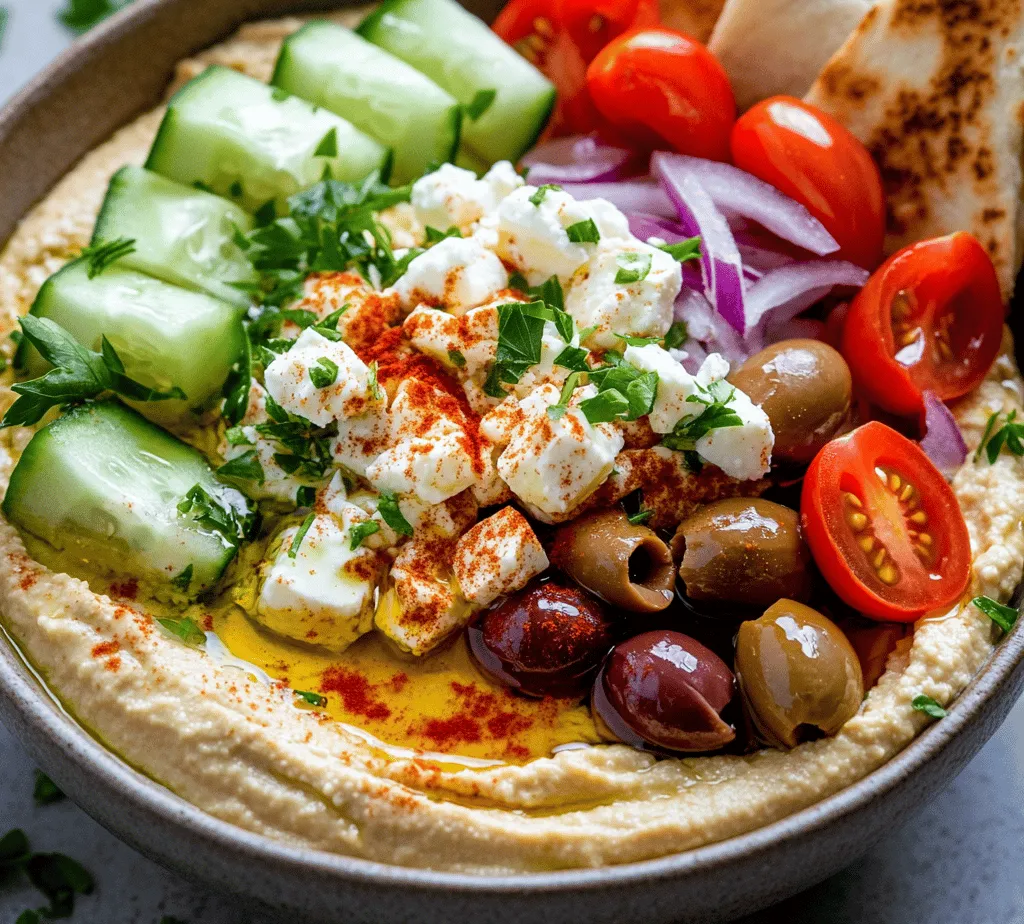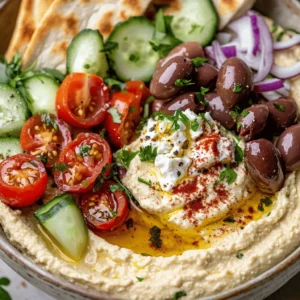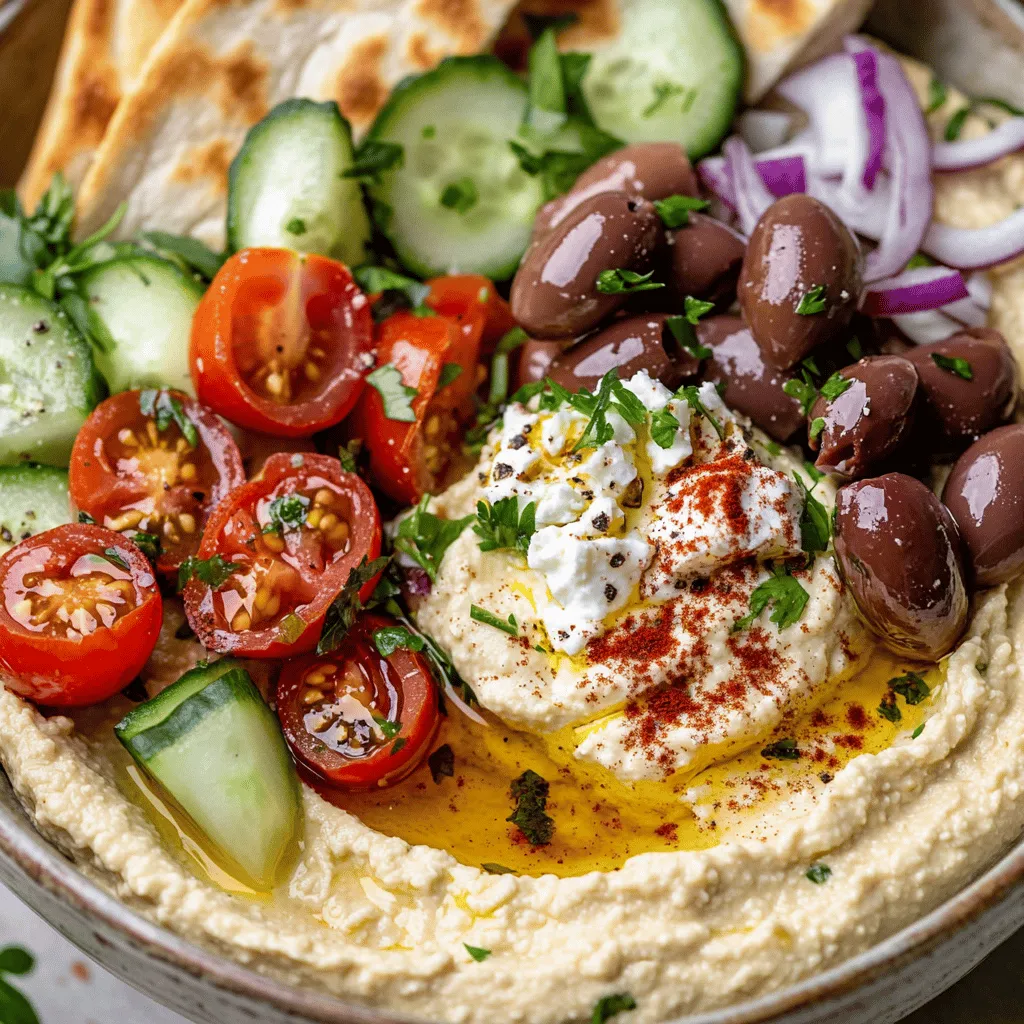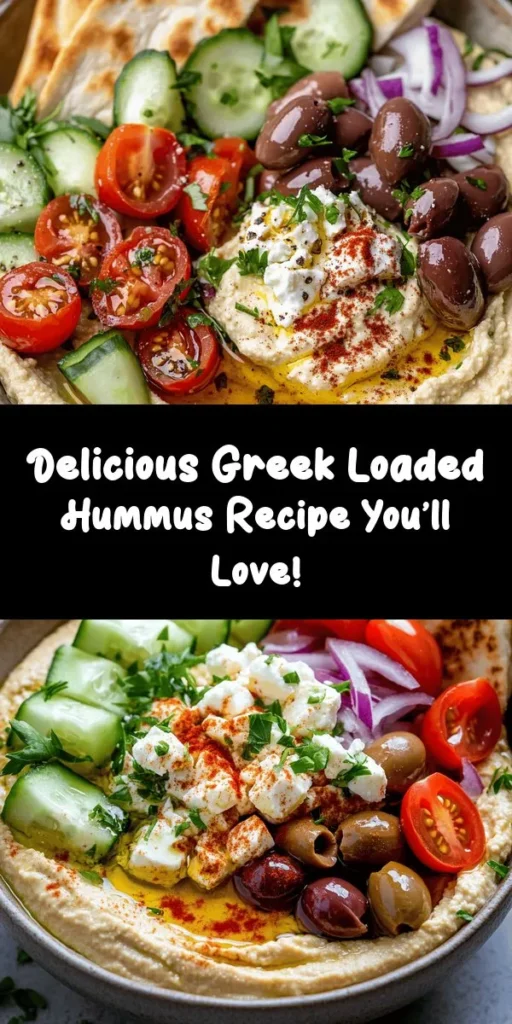In the world of Mediterranean cuisine, few dishes are as beloved and versatile as hummus. This creamy chickpea spread has transcended its roots to become a staple in many households around the globe. Among its many variations, Greek Style Loaded Hummus stands out for its vibrant flavors and impressive presentation. This dish not only delights the palate but also serves as a nutritious option for gatherings or a satisfying snack.
Hummus can serve as a base for various toppings, making it a canvas for culinary creativity. Greek Style Loaded Hummus elevates this classic dish to new heights, incorporating fresh vegetables, herbs, and a drizzle of olive oil that reflect the flavors of the Mediterranean. This article will explore the distinct elements that make Greek Style Loaded Hummus a must-try recipe, including its health benefits, preparation steps, and suggestions for serving.
Understanding Hummus: A Mediterranean Staple
Exploring the Origins of Hummus
Hummus has a rich and storied past that dates back thousands of years. While its exact origins are debated, it is widely believed to have roots in the Levant region, encompassing countries like Lebanon, Syria, and Palestine. The earliest references to chickpeas and tahini, the two main ingredients in hummus, can be traced back to ancient cultures in the Middle East. Over the centuries, hummus has evolved, with various regions adding their unique flavors and ingredients, resulting in a multitude of delicious variations.
Cultural significance is deeply embedded in the experience of sharing hummus. Traditionally served as an appetizer or a meze, hummus often accompanies gatherings, encouraging communal eating and conversation. Its popularity has spread beyond its cultural origins, becoming a favorite in many parts of the world, where it is enjoyed as a dip, spread, or even as a salad base.
Nutritional Benefits of Hummus
Hummus is not just a delicious option; it is also packed with nutrition. The primary ingredient, chickpeas, is a fantastic source of plant-based protein, making hummus a great option for vegetarians and vegans. A typical serving of hummus contains about 2 grams of protein per tablespoon, contributing to a balanced diet.
In addition to protein, chickpeas are rich in dietary fiber, which supports digestive health and can help with weight management by promoting a feeling of fullness. The healthy fats found in tahini and olive oil provide essential fatty acids, which are beneficial for heart health. Moreover, the addition of fresh vegetables and herbs not only enhances the flavor profile of Greek Style Loaded Hummus but also boosts its nutrient content, offering vitamins, minerals, and antioxidants.
Ingredients for Greek Style Loaded Hummus
Overview of Essential Ingredients
Creating Greek Style Loaded Hummus requires a harmonious blend of ingredients that work together to build flavor and texture. Below is a comprehensive list of essential ingredients for this delightful dish:
– Chickpeas: The foundation of hummus, providing creaminess and protein.
– Tahini: A paste made from ground sesame seeds, essential for achieving a rich, smooth texture.
– Olive oil: Adds healthy fats and enhances the flavor profile.
– Garlic: Fresh garlic cloves provide a robust flavor that complements the chickpeas.
– Lemon juice: Freshly squeezed lemon juice adds acidity and brightness to the dish.
– Cumin: A dash of ground cumin introduces warm, earthy notes.
– Salt and pepper: Essential for seasoning and enhancing overall flavor.
– Fresh vegetables: Cucumbers, tomatoes, and olives for topping.
– Fresh herbs: Parsley adds a refreshing note to the final presentation.
Each of these ingredients plays a crucial role in creating the creamy, flavorful experience that is Greek Style Loaded Hummus.
Chickpeas: The Heart of Hummus
Chickpeas, also known as garbanzo beans, are the heart of any hummus recipe. They are legumes that are not only delicious but also highly nutritious. A single serving of chickpeas offers significant amounts of protein, fiber, and essential vitamins and minerals, including folate, iron, and magnesium.
When preparing chickpeas for hummus, you have two options: using canned chickpeas or cooking dried chickpeas. Canned chickpeas are convenient and can save you time, but if you choose to use dried chickpeas, soak them overnight and cook them until tender for a fresher taste. Whichever option you choose, be sure to rinse and drain the chickpeas before blending to remove excess sodium or impurities.
Tahini: The Creamy Enhancer
Tahini is a key ingredient in hummus, contributing to its signature creamy texture and rich flavor. Made from ground sesame seeds, tahini has a slightly nutty taste that complements the earthiness of chickpeas. Beyond its flavor, tahini is also a nutritional powerhouse, packed with healthy fats, protein, and various vitamins and minerals, including calcium and iron.
When selecting tahini, look for high-quality, pure tahini without additives. The consistency can vary, so if you find it too thick, simply stir in a little warm water or lemon juice to achieve the desired texture before incorporating it into your hummus.
The Role of Fresh Vegetables and Herbs
The toppings for Greek Style Loaded Hummus are just as important as the base. Fresh vegetables like cucumbers and tomatoes not only add vibrant color but also provide a satisfying crunch and refreshing flavor that balances the creaminess of the hummus. Olives, particularly Kalamata olives, add a briny richness that complements the other ingredients beautifully.
Fresh herbs, such as parsley or mint, contribute an aromatic freshness that brightens the dish. They also add a pop of color, making your hummus visually appealing. When preparing your toppings, chop the vegetables and herbs finely for even distribution over the hummus, enhancing both flavor and presentation.
Step-by-Step Guide to Making Greek Style Loaded Hummus
Preparation Process Overview
Making Greek Style Loaded Hummus is a straightforward process that can be accomplished in just a few simple steps. This dish is perfect for both seasoned cooks and beginners alike, allowing anyone to create a delicious Mediterranean treat without requiring extensive culinary skills.
To begin, gather all the necessary ingredients and equipment, including a food processor or blender, a mixing bowl, and serving dishes. The preparation involves blending the base ingredients to form the hummus, preparing the fresh toppings, and assembling the final dish.
The simplicity and speed of creating Greek Style Loaded Hummus make it an ideal choice for entertaining or enjoying as a healthy snack. The blend of flavors and textures will leave you and your guests wanting more, making this dish a true crowd-pleaser.
With the ingredients and preparation process in mind, let’s dive into the detailed steps to create this delicious hummus that captures the essence of Greek cuisine. Stay tuned for the next section where we will provide a complete step-by-step guide to crafting your own Greek Style Loaded Hummus at home.

Blending the Base Ingredients
To achieve the perfect Greek Style Loaded Hummus, the first step is to blend the base ingredients to create a smooth and creamy foundation. Begin by draining and rinsing one can of chickpeas (about 15 ounces). This helps remove any excess sodium and improves the overall flavor. Place the chickpeas in a food processor along with 1/4 cup of tahini, 2 tablespoons of extra virgin olive oil, the juice of one medium lemon, 2 cloves of garlic (minced), 1 teaspoon of ground cumin, and a pinch of salt and pepper to taste.
When blending, it’s essential to process the ingredients until they are completely smooth. This may take several minutes, so don’t rush the process. If the mixture appears too thick or chunky, you can help achieve the desired consistency by adding a tablespoon of cold water at a time until it reaches your preferred creaminess. Remember, the smoother the hummus, the better it will hold up as a base for the toppings. For an extra creamy texture, consider using peeled chickpeas, which can be done by gently squeezing them out of their skins before blending.
Creating the Greek Yogurt Layer
Once the hummus base is ready, it’s time to prepare the Greek yogurt layer which is crucial for adding an extra element of creaminess and tanginess. In a mixing bowl, combine one cup of thick Greek yogurt with the zest of one lemon and a pinch of salt. For added flavor, you might incorporate a drizzle of honey or a sprinkle of dill or oregano, enhancing the Mediterranean vibe of the dish.
This layer not only increases the richness of the hummus but also balances the flavors beautifully. Spread the yogurt mixture evenly over the smooth hummus layer in your serving dish. The contrast between the creamy yogurt and the velvety hummus is visually appealing and invites your guests to dig in.
Layering the Toppings
Now comes the fun part—layering the toppings! This step is where you can let your creativity shine. Begin with diced cucumber, which adds a refreshing crunch. Next, scatter vibrant cherry tomatoes, halved or quartered, for a burst of color and sweetness. Then, add a generous handful of Kalamata olives, pitted and sliced; their briny flavor complements the creaminess of the yogurt and hummus nicely.
Finally, crumbling feta cheese on top not only enhances the flavor but also gives a beautiful contrast in texture. The tangy and salty feta pairs perfectly with the other toppings, making each bite a delightful experience. Aim for an even distribution of all toppings to ensure that every scoop of hummus carries a bit of everything, creating a harmonious blend of Mediterranean flavors.
Finishing Touches
To elevate your Greek Style Loaded Hummus, consider adding some finishing touches. Thinly slice a small red onion and scatter it over the top for a zesty bite. A sprinkle of fresh parsley adds a pop of color and freshness that brightens the dish. Drizzle a little more olive oil over the entire platter for an extra layer of richness and shine. For a hint of spice, a light dusting of paprika or sumac can enhance the presentation and flavor profile.
These final garnishes not only make the dish look inviting but also contribute additional layers of flavor that enhance the overall experience. The vibrant colors and textures will surely draw attention, making your Greek Style Loaded Hummus a centerpiece for any gathering.
Serving Suggestions for Greek Style Loaded Hummus
Ideal Accompaniments
When it comes to serving Greek Style Loaded Hummus, the right accompaniments can enhance the experience. Fresh pita bread is a classic choice; you can serve it warm and cut into triangles for easy dipping. Alternatively, pita chips provide a satisfying crunch that pairs well with the creamy hummus. For a healthier option, consider serving an assortment of fresh vegetable sticks, such as carrots, celery, and bell peppers. These crunchy vegetables not only add texture but also provide a refreshing contrast to the rich flavors of the hummus.
Another delightful option is to create a mezze platter. Arrange your loaded hummus alongside various dips, olives, stuffed grape leaves, and roasted vegetables. This allows guests to sample a variety of flavors and creates a communal dining experience that is central to Mediterranean culture.
Creative Serving Ideas
Serving Greek Style Loaded Hummus can be as creative as you want it to be. For a more individual approach, consider portioning the hummus into jars. This not only looks appealing but also makes for a practical and hygienic option for gatherings. Each guest can have their own jar, complete with layers of hummus, yogurt, and toppings.
Additionally, you can serve the hummus as part of a larger spread during a dinner party or potluck. Pair it with grilled meats, roasted vegetables, and salads to create a full Mediterranean feast. The versatility of this dish makes it suitable for both casual and formal occasions, ensuring that it can adapt to various settings and preferences.
Variations and Customizations
Exploring Flavor Variations
While the traditional Greek Style Loaded Hummus is delightful on its own, there are many flavor variations you can explore. For those who enjoy a hint of sweetness, consider adding roasted red peppers into the hummus before blending. This will impart a smoky flavor and a vibrant color. Alternatively, sun-dried tomatoes can add a tangy depth to the hummus, creating a unique twist. For spice lovers, a pinch of cayenne pepper or a dash of sriracha can add a kick that elevates the dish to new heights.
You can also experiment with herbs. Fresh basil or mint can be blended into the hummus for a fresh twist, while a sprinkle of za’atar can provide an aromatic layer of flavor that complements the Mediterranean theme.
Dietary Modifications
This recipe is inherently flexible and can be modified to suit various dietary needs. For a vegan version, ensure that the Greek yogurt is replaced with a plant-based alternative, such as coconut yogurt or cashew cream. Many brands offer delicious dairy-free yogurt that can mimic the creaminess of Greek yogurt.
If you need to accommodate gluten-free diets, simply ensure that all accompaniments, such as pita chips or crackers, are certified gluten-free. The hummus itself is naturally gluten-free, making it a perfect option for those with gluten sensitivities.
Conclusion: The Joy of Greek Style Loaded Hummus
Greek Style Loaded Hummus is not just a dish; it’s a celebration of flavors that encapsulates the essence of Mediterranean cuisine. Its creamy texture, vibrant colors, and rich flavors make it a delightful addition to any table, whether for casual gatherings, festive occasions, or as a satisfying snack.
Not only is this recipe easy to prepare and customizable, but it also offers numerous nutritional benefits. Packed with protein from chickpeas, healthy fats from olive oil and tahini, and a variety of vitamins from the fresh toppings, it can be a wholesome choice for everyone.
Embrace the joy of sharing this loaded hummus with friends and family, as it invites a communal experience that encourages conversation and connection. Allow the inviting aromas and flavors to transport you to the sun-drenched shores of Greece, and make this recipe a staple in your culinary repertoire. Try it out, and enjoy the vibrant tastes and textures that make Greek Style Loaded Hummus a dish worth celebrating.



